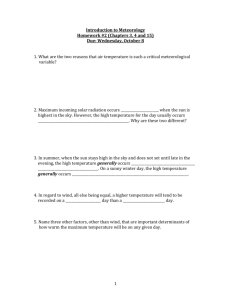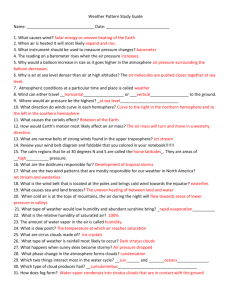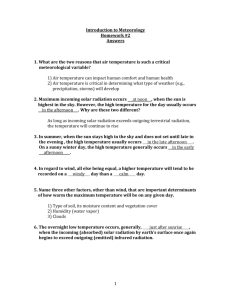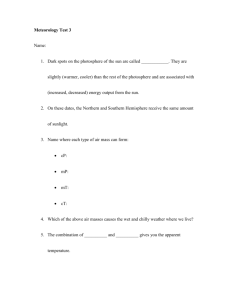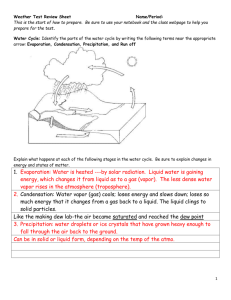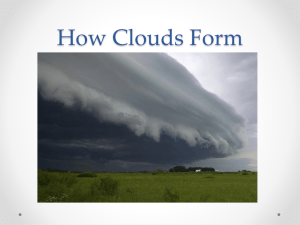917 Lecture, Moisture, Clouds
advertisement
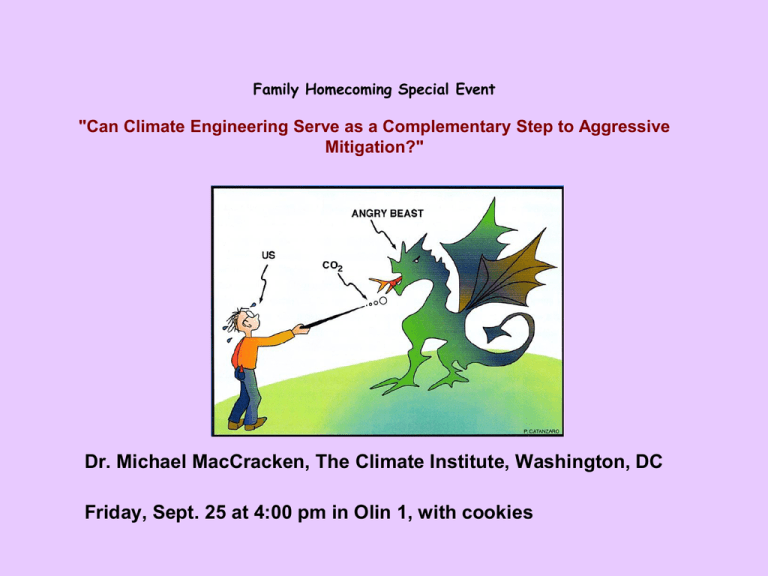
Family Homecoming Special Event "Can Climate Engineering Serve as a Complementary Step to Aggressive Mitigation?" Dr. Michael MacCracken, The Climate Institute, Washington, DC Friday, Sept. 25 at 4:00 pm in Olin 1, with cookies Dalton’s Law of Partial Pressures The total pressure of the air is the sum of the partial pressures of its component gases. Ptotal = PN2 + PO2 + e + Ptrace Total = Nitrogen + Oxygen + Water Vapor + Trace Gases Moisture, Clouds Precipitation Moisture Moisture is critically important to all sorts of weather phenomena. If our atmosphere was as dry as Mars, we would have winds and sandstorms, and that’s about it. On Earth, we have dew, fog, mist, clouds, frost, rain, snow, sleet, hail, ice, colored sunsets, rivers, lakes, oceans, and many other phenomena -- all because of moisture. Moisture controls the heat budget of the planet Water vapor is a major greenhouse gas. Clouds, snow and ice reflect sunlight back to space. Sensible heat is carried by winds and ocean currents Oceans store heat and moderate coastal climates. Snow is an effective insulator. Vegetation alters both the heat and moisture budgets. Latent (or hidden) heat is exchanged when water changes from one phase to another. Latent heat powers weather systems Measuring humidity Sling psychrometer -- ventilated wet bulb and dry bulb thermometers. Hair hygrometer -- hair lengthens with humidity (about 2.5%). Twisted hair generates torsion. Dew Cell -- measures humidity by an electrical conductor coated with LiCl, a chemical whose conductivity varies with moisture. Ice highly orderly lower energy lower temperature Liquid one free surface Vapor random higher energy higher temperature Sublimation, melting, and evaporation all require heat from the environment. Deposition, freezing, and condensation all release heat to the environment. Temperature and phase changes of 1 gram of ice as energy is added. Relative Humidity Vapor pressure, e is that portion of the total air pressure exerted by the water vapor. From Dalton’s Law of Partial Pressures, e = P (H2O). Saturation vapor pressure, es is the maximum possible e at a given T. It assumes that the water vapor and a plane water surface are in equilibrium. Relative Humidity RH = e/es x 100% Air does not “hold” water vapor; the dry gases in the air coexist with water vapor near the ground. It is temperature (mainly) that affects the rate of water vaporization. Imagine water molecules leaving and entering Johnson Pond. When they are inequilibrium (for a given T) then you measure e. As temperatures drop overnight… e lowers and RH rises If a fog covers the pond, then you can assume e ~ es Dew Point Dew Point, Td is the temperature to which air must be cooled at constant pressure to reach saturation. Dew point indicates the temperature at which dew, frost, fog may occur. Often the dew point temperature in the evening is a good predictor of the overnight minimum temperature? Why? High Td means high absolute humidity. If T and Td are almost the same then RH is high. If T = Td, then RH = 100% Anthes Fig. 1.9 Saturation vapor pressure and density as a function of T Insert is for liquid and ice below 0 oC “Boiling” The boiling point is defined as the temperature at which the saturation vapor pressure of a liquid (es) is equal to the surrounding atmospheric pressure. For water, es = 1 atm. at 100 C. At pressures greater than 1 atm. (e.g. in a pressure cooker), the boiling temperature is greater than 100 C. At pressures lower than 1 atm. (e.g. on a mountain top), the boiling temperature is less than 100 C. BOILING occurs when es = 1 atm. Clouds Clouds are aesthetically pleasing. They generate rainbows, cloudbows, halos, and gorgeous sunsets. Cloudscapes are half of all “landscapes.” Clouds indicate important meteorological processes such as convection, fronts, and mountain waves. Clouds are the source of rain, snow, thunder, lightning, hail, and many other weather phenomena. The Earth from space appears to be about 50% covered by white clouds of all shapes. Clouds Eternal Clouds, let us appear; let us arise from the roaring depths of Ocean, our father; let us fly towards the lofty mountains, spread our damp wings over their forestladen summits. . . let us shake off the rainy fogs, which hide our immortal beauty and sweep the earth from afar with our gaze -- Aristophanes, The Clouds I am the daughter of Earth and Water, And the nursling of the Sky; I pass through the pores of the ocean and shores; I change, but I cannot die. -- Percy Bysshe Shelley, The Cloud Four Basic Cloud Types High, cloud bases above 5.5 km (18,000 ft) Icy, wispy High overcast High with lumps “mackerel sky” Cirrus (Ci), Cirrostratus (Cs), Cirrocumulis (Cc) Middle, cloud bases 2-5.5 km (7,000 - 18,000 ft) Mid-level overcast Mid level with lumps Altostratus (As), Altocumulus (Ac) Low, cloud bases 0-2 km (surface to 7,000 ft) Ground Low overcast Low lumpy Fog, Stratus (St), Stratocumulus (Sc), Fair weather Cumulus (Cu) Vertical Development, cloud bases 1 km (3500 ft) thick 10 km (30,000 ft) Steady rain Showery and stormy Nimbostratus Cumulonimbus (Cb)
